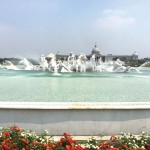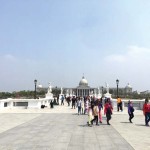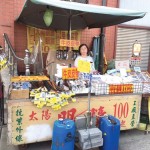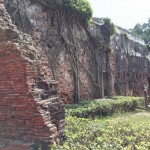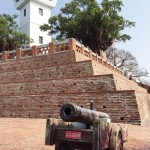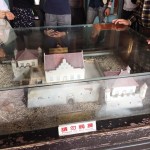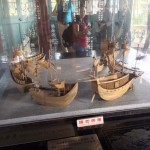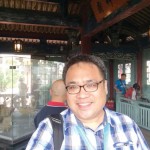Historical Kaohsiung front and center
- The Apollo Fountain Plaza with the Chi Mei Museum in the background. (Photos by MARK RABAGO)
- The Chi Mei Museum was donated by Chi Mei Corp. founder Shi Wen-long to the Tainan government in 1992.
- A street seller hawks her goods near the Chikanlou Fort.
- The mortar used to secure the bricks of the Chikanlou Fort was made out of a mixture of ground oyster shells, syrup, and glutinous rice as no cement was used.
- The Chikanlou Fort was built by Dutch colonizers in 1652.
- A replica of the Anping Fort as it was during its heyday.
- Replicas of Ming Dynasty loyalist Koxinga’s battleships.
- The author takes a selfie at Anping Fort.
- The Anping Fort memorializes the Dutch surrender to Koxinga with a statue, right.
KAOHSIUNG, Taiwan—A 14-storey museum done in the European-style architecture, a couple of forts that harken back to the island’s brief but poignant Dutch colonial period, and a reminder that Taiwan could very well be the scooter capital of the region were the highlights of the familiarization tour Resorts World Manila organized for its Stay and Cruise promotion.
Media from the CNMI and Guam and promotion partners aboard the SuperStar Virgo luxury liner had their second port of call Tuesday at this southern Taiwanese city of around 2.7 million people.
The historical tour started with an hour-long bus ride to Tainan where the first stop was Chi Mei Museum. It was built by Chi Mei Corp. founder Shi Wen-long in 1992 and donated to the Tainan government in 2012. The museum has an extensive collection of Western art, musical instruments that include an antique Stradivarius, Guarneri del Gesu, and Nicolo Amati violins, weaponry, and natural history.
While the group skipped the museum tour, it was able to marvel and take photos—selfies and groupies mostly—of the museum’s impressive Greek-style architecture outside, among them the Muse Plaza, Apollo Fountain Plaza, Olympus, bridge, and Cherub Fountain.
After a quick lunch at the peculiarly named Chih Kan Pedder’s Noodle Restaurant, the group headed to Chikanlou, a fort built by the Dutch colonizers in 1652.
Originally called Provintia, Chikanlou (in Dutch, it means eternity), the fort maintains its original look, despite having gone through the Ming Dynasty, Qing Dynasty, and the Japanese colonization period.
A marker described the method the Dutch used to make the fort’s impressive red brick walls. It entailed filling the walls with “gnarled leaves and branches of banyan trees, portraying the beauty and sadness of olden days.” They also incorporated the “iron scissors” or “wall lock” technique that was used to secure the beams and walls to prevent detachment.
The mortar used to secure the bricks together was made out of a mixture of ground oyster shells, syrup, and glutinous rice as no cement was used.
It’s also worth noting that, coincidentally, the wall’s reddish hue perfectly matched the locks of many Dutch colonizers, who the natives called “red-haired barbarians.”
The next stop was the Anping Fort, which the Dutch built in 1624. Formerly called Fort Zeelandia, it was the administrative center of the Dutch regime and the hub for trading.
The building was originally constructed as a square inner fortress and rectangular outer walls. In 1661, the fort was renamed Anping to commemorate Ming Dynasty loyalist Koxinga’s almost mythical exploits in driving the Dutch out of Taiwan.
Koxinga’s exploits of ridding Formosa, Taiwan’s original name, of the “red-haired barbarians” is one of the reasons statues of him adorn both the Chikanlou and Anping forts.
It’s also quite notable that the year when Koxinga was born and died—1624 and 1662—coincided with the start and end of the Dutch colonial period in Taiwan. It’s as if Koxinga was just put on this earth solely to rid the island of the “red-haired barbarians.”
After the trip to Anping Fort, the group was able to procure pineapple cake goodies from the Virgo Bakery in Kaohsiung.
During the six-hour tour of Kaohsiung and nearby Tainan, it also became quite evident that the Taiwanese have fallen madly in love with scooters of every make and kind for their daily commute.
This assertion was even confirmed by the group’s tour agent, Tim, who said families in the Republic of China usually have up to four scooters compared to two cars in their garages.
The group continued its familiarization tour of SuperStar Virgo’s six-day and five-night cruise to Laoag (Currimao), Philippines, Taiwan, and Hong Kong, China by steaming toward the former British crown yesterday.
The 882-foot, over 75,000-gross ton SuperStar Virgo could accommodate up to 1,870 passengers and was designed specifically for the Asian cruise market.
With rates starting at just $655 per person, you can stay at two properties of Resorts World Manila—the Philippines’ premier integrated entertainment and tourism destination—and go on a cruise aboard SuperStar Virgo as the luxury liner makes Manila its new homeport from March 19 to May 23.
Sailing dates are March 24 and 29, April 3, 8, 13, 18, 23, and 28, and May 3, 8, 13, 18, and 23.
Guam and Saipan residents can directly avail of the Stay and Cruise package using credit card payments through the SSV RWM BUNDLE option at www.rwmanila.com/stayandcruise. The package is inclusive of two-night accommodations at Resorts World Manila hotels.
Those interested can also call John Hagemann at +63917878583/john.hagemann@rwmanila.com or Janine Chua at +639178788576/ janine.chua@rwmanila for more details. For other inquiries and reservations, contact Tourist/Visitor Hotline at (02) 908-8833 or visit www.rwmanila.com.



